Sarah L. Johnson's Blog, page 103
June 7, 2014
A look at Nicola Upson's Fear in the Sunlight
This beautifully written psychological crime novel snuck up on me. For the longest while, I wasn't sure how well this book and I would get on – it's fourth in a series featuring novelist Josephine Tey, and every chapter seemed to introduce a new viewpoint. It was akin to walking into a crowded party where everyone already knew one another. (As it turns out in the case of the novel's characters, this is hardly true.) It was also a strange experience to see a historical author referred to by her pseudonym. Scottish novelist Elizabeth Mackintosh, an enigmatic figure, wrote a number of mysteries as Tey, including the classic novel beloved by Ricardians, The Daughter of Time.
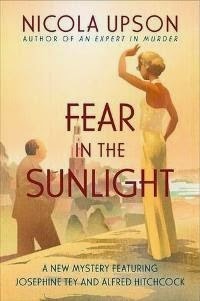 But I was slowly won over by the lingering moodiness of the tone, which sat in contrast with the idyllic setting of Portmeirion, an Italianate resort village in North Wales, and the alluring glamour of the film industry in the mid-1930s. It's at Portmeirion where a large cast has gathered to celebrate Josephine's 40th birthday, and where Alfred Hitchcock and his wife, Alma Reville, hope to persuade her to let them turn her mystery A Shilling for Candles into a film. Here, a number of characters, including both Josephine and her friend, Scotland Yard inspector Archie Penrose, meet up with events from their pasts: some welcome and some sinister, all complicated.
But I was slowly won over by the lingering moodiness of the tone, which sat in contrast with the idyllic setting of Portmeirion, an Italianate resort village in North Wales, and the alluring glamour of the film industry in the mid-1930s. It's at Portmeirion where a large cast has gathered to celebrate Josephine's 40th birthday, and where Alfred Hitchcock and his wife, Alma Reville, hope to persuade her to let them turn her mystery A Shilling for Candles into a film. Here, a number of characters, including both Josephine and her friend, Scotland Yard inspector Archie Penrose, meet up with events from their pasts: some welcome and some sinister, all complicated.
The title is perfect; Hitchcock articulates its meaning in the novel, and as with his movies, the author knows the best techniques for evoking feelings of dread that are all the more powerful for being unexpected. If the mystery element appears to take a frustratingly long time to emerge, the title should be kept in mind. There were details of the crimes committed that I found painfully realistic, and difficult to read. Upson also skillfully illustrates the deep emotions of love and longing, and the sense of grief that permeates the earlier and later sections – set in 1954, two years after Tey's death – is among the most haunting that I've ever read.
Fear in the Sunlight was published by Harper Paperbacks in 2013. I bought a Kindle copy after getting an email from BookPerk (HarperCollins' e-list for ebook bargains), and I read it on the plane going to and from BEA. First in the series is An Expert in Murder.
 But I was slowly won over by the lingering moodiness of the tone, which sat in contrast with the idyllic setting of Portmeirion, an Italianate resort village in North Wales, and the alluring glamour of the film industry in the mid-1930s. It's at Portmeirion where a large cast has gathered to celebrate Josephine's 40th birthday, and where Alfred Hitchcock and his wife, Alma Reville, hope to persuade her to let them turn her mystery A Shilling for Candles into a film. Here, a number of characters, including both Josephine and her friend, Scotland Yard inspector Archie Penrose, meet up with events from their pasts: some welcome and some sinister, all complicated.
But I was slowly won over by the lingering moodiness of the tone, which sat in contrast with the idyllic setting of Portmeirion, an Italianate resort village in North Wales, and the alluring glamour of the film industry in the mid-1930s. It's at Portmeirion where a large cast has gathered to celebrate Josephine's 40th birthday, and where Alfred Hitchcock and his wife, Alma Reville, hope to persuade her to let them turn her mystery A Shilling for Candles into a film. Here, a number of characters, including both Josephine and her friend, Scotland Yard inspector Archie Penrose, meet up with events from their pasts: some welcome and some sinister, all complicated.The title is perfect; Hitchcock articulates its meaning in the novel, and as with his movies, the author knows the best techniques for evoking feelings of dread that are all the more powerful for being unexpected. If the mystery element appears to take a frustratingly long time to emerge, the title should be kept in mind. There were details of the crimes committed that I found painfully realistic, and difficult to read. Upson also skillfully illustrates the deep emotions of love and longing, and the sense of grief that permeates the earlier and later sections – set in 1954, two years after Tey's death – is among the most haunting that I've ever read.
Fear in the Sunlight was published by Harper Paperbacks in 2013. I bought a Kindle copy after getting an email from BookPerk (HarperCollins' e-list for ebook bargains), and I read it on the plane going to and from BEA. First in the series is An Expert in Murder.
Published on June 07, 2014 07:41
June 5, 2014
Book review: The Devil in the Marshalsea, by Antonia Hodgson
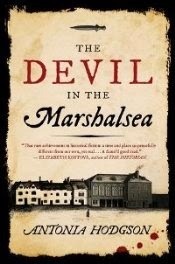 As promised in the historical note that opens Hodgson’s satisfyingly twisty debut thriller, readers will encounter an eye-opening look at Georgian London’s debtors’ prisons and some authentically colorful swearing within its pages. Tom Hawkins experiences both of these when he’s thrown into the Marshalsea Gaol after too many gambling losses and a near-fatal mugging.
As promised in the historical note that opens Hodgson’s satisfyingly twisty debut thriller, readers will encounter an eye-opening look at Georgian London’s debtors’ prisons and some authentically colorful swearing within its pages. Tom Hawkins experiences both of these when he’s thrown into the Marshalsea Gaol after too many gambling losses and a near-fatal mugging.To his surprise, the Marshalsea seems like a miniature town, complete with a tap room, coffeehouse, and barber. “Indeed it reminded me of my old college, save for the iron spikes,” he observes. But after meeting many disreputable characters and hearing screams coming from the gaol’s “Common Side,” where those too broke to afford their upkeep are left to rot, he almost regrets not obeying his estranged father and becoming a clergyman.
Complicating matters further are Samuel Fleet, Tom’s fear-inducing roommate, and conspiracies surrounding a former prisoner whose ghost reportedly roams—and whose murder Tom must solve, or else. The squalid atmosphere is so well detailed that one can almost smell the corruption, and the irrepressibly roguish Tom makes a winning hero.
The Devil in the Marshalsea, first in a new series, will be published by Houghton/Mariner in trade paperback on June 10th (400pp, $15.95). This review first appeared in Booklist's April 15th issue. The author will shortly be touring the blogosphere with Historical Fiction Virtual Book Tours, and she'll be stopping by here with an interview on Friday, June 20th.
Published on June 05, 2014 07:57
June 3, 2014
In which I read Goodnight June, by Sarah Jio
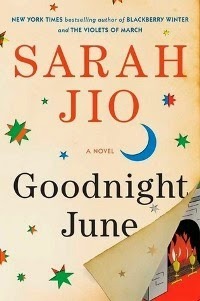 It's been a while since I've been as emotionally caught up in a book as I was with Sarah Jio's Goodnight June. Writing with a light touch, she has a gift of reaching deeply into issues that matter to her readers – in this case the importance of children's literature, the value of books and bookstores in our technology-driven age, and the complicated bonds between sisters. Here, she ties all of these themes together with relatable, human characters and a heartfelt tribute to Margaret Wise Brown's classic children's book, Goodnight Moon.
It's been a while since I've been as emotionally caught up in a book as I was with Sarah Jio's Goodnight June. Writing with a light touch, she has a gift of reaching deeply into issues that matter to her readers – in this case the importance of children's literature, the value of books and bookstores in our technology-driven age, and the complicated bonds between sisters. Here, she ties all of these themes together with relatable, human characters and a heartfelt tribute to Margaret Wise Brown's classic children's book, Goodnight Moon.In 2005, June Andersen is a high-powered New York financier responsible for foreclosing on small businesses that have missed too many mortgage payments. She's the type of person that owners of Mom-and-Pop stores love to hate, for good reason... and although she's very good at her job, her blood pressure is soaring, and she doesn't like what she's become.
When she receives word about the death of her Great-Aunt Ruby back in her hometown of Seattle and learns she's inherited Bluebird Books, the children's bookstore Ruby had founded in the 1940s, June takes her first vacation days in years and flies back home, intending to sell the assets and return to Manhattan as soon as she can. But as she sorts through old books, papers, and memories at the store, then meets Gavin, owner of the Italian restaurant next door, she starts wondering where her future really lies.
From the beginning, it's clear that the novel will deal with June's personal transformation as she slowly reconnects with everything she had left behind and decides, ultimately, that Ruby's beloved store is worth saving. Although I had a good feel for the outcome of that part of June's tale, I remained wrapped up in it, and there were many surprises in store, too. The novel's historical aspect derives from a literary scavenger hunt in which June discovers a series of letters dating from the '40s between Ruby and her good friend, Margaret Wise Brown, in which they share confidences and bounce ideas off one another. Both women have challenging relationships with their sisters (something June is also experiencing herself), and struggle with pursuing lives of their own choosing despite disapproval or disdain from others.
June's reminiscences about her former closeness with her estranged younger sister, Amy, took me on a nostalgic journey back to the toys and books of my childhood (did anyone else ever have an Easy-Bake Oven or play Old Maid?). And anyone who thinks that writing for children is a lesser or less worthy accomplishment than composing Highbrow Literature should read this novel for enlightenment. It drew me in continuously with one revelation after another, some predictable and some the opposite. By the end I was happily overwhelmed by her characters' unceasing efforts to do the right thing for themselves and for one another.
Sarah Jio's Goodnight June was published on May 27th by Plume in trade paperback ($16.00) and on Kindle ($7.99). Thanks to the author's publicist for dropping a NetGalley widget into my inbox.
Published on June 03, 2014 08:00
May 28, 2014
My summer and fall historical fiction picks, part 2
Here's the second entry in my series of posts about historical novels I'm keeping an eye out for this summer and fall (part one is here). Although I haven't been seeking out new books for review, generally, these are titles I'd happily make exceptions for! As usual for these lists, the settings are all over the place, but that's the way I like it.
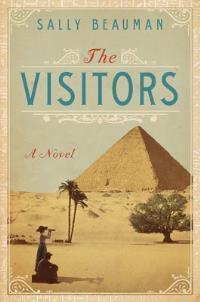
An epic novel of adventure, discovery, and the effects of colonialism, centering on the search for the tomb of Tutankhamen in the early 1920s. Here, the events are seen from the viewpoint of a young English girl. Harper, July 2014.
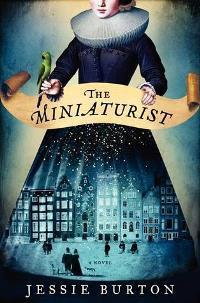
A young, neglected wife in 1680s Amsterdam is given an unexpected wedding gift: a miniature house that looks just like her residence, and whose mysterious furnishings give her unexpected insight into the household. I'll be formally reviewing this one later on. Ecco, September 2014.
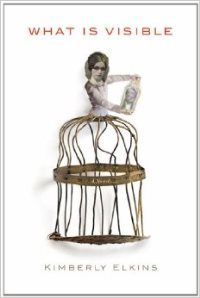
As a child, I was given a copy of Edith Fisher Hunter's inspiring Child of the Silent Night, a book about Laura Bridgman, a blind and deaf girl from early 19th-century New England who learned to communicate in English. Kimberly Elkins' literary debut novel narrates the book in Laura's imagined voice, and I'm curious to read her interpretation. Twelve, June 2014.
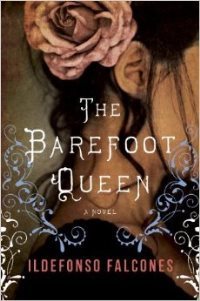
The setting and characters of this novel caught my attention: it's about a former Cuban slave and a gypsy living on the fringes of society in 18th-century Spain. This is the Barcelona-based author's 3rd book to be translated into English, following Cathedral of the Sea and The Hand of Fatima. Crown, November 2014.
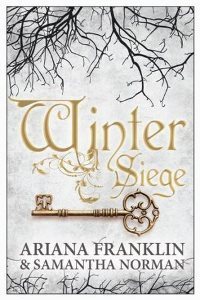
To say that this novel is highly anticipated is an understatement. Ariana Franklin's (aka Diana Norman) final work, completed after her death by her daughter, takes place in her home turf of 12th-century England and is a standalone historical novel set in the fenlands. Bantam UK, October 2014.

Goddess is the adult fiction debut from an Australian novelist who has previously written a number of highly regarded YA historical novels and children's titles. I hadn't heard of Julie d'Aubigny before, but the publisher's blurb tells me she was an opera singer and swordswoman, a lover of both men and women whose flamboyant ways both fascinated and outraged 17th-century France. I'm eager to read her story (US readers can get it on Kindle, like I did). Fourth Estate Australia, June 2014.
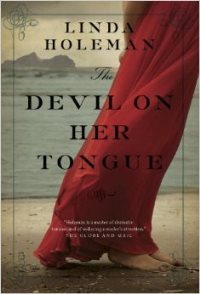
I can always rely on Linda Holeman's novels to whisk me away to locales where I've never been. Her latest book envisions 18th-century Portugal through the eyes of a half-Dutch, half-African young woman determined to lift herself out of poverty and create a better life for herself. Random House Canada, June 2014.
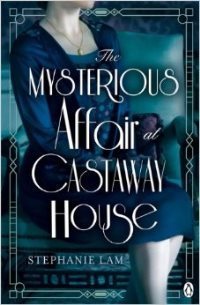
As you can guess from the title, this is a gothic mystery involving a creepy old house, which of course is why I'm listing it here. The main thread takes place in an English seaside town in 1965. A runaway gets caught up in discovering secrets dating from the '20s, when a young man came to stay with his cousin at Castaway House.. Penguin UK, September 2014.
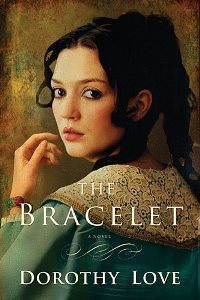
Just like the author's Carolina Gold, a beautifully written Southern historical that should appeal equally to Christian and secular readers alike, The Bracelet takes inspiration from real events. Set in 19th-century Savannah, a young woman seeks the truth about a tragedy that occurred in her home during her childhood. And what a beautiful cover! Thomas Nelson, December 2014.
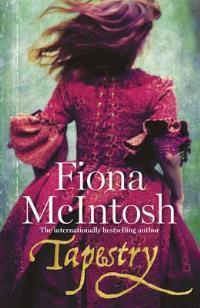
Having recently finished McIntosh's The Tailor's Girl, a romantic novel set in WWI-era England, I'm eager to dive into her newest book: a time-slip novel taking readers from 1970s England to Scotland during the Jacobite rebellion. HarperCollins Australia, May 2014.
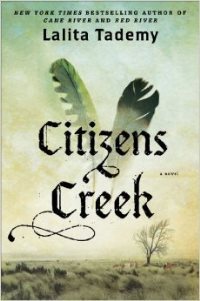
From the author of Cane River comes a new novel that tells the parallel stories of Cow Tom, a historical figure born into slavery who became an accomplished translator for the Muskogee Nation in the mid-19th century, and his granddaughter, Rose, who battles racial oppression in her own time. This is an aspect of American history that's important yet too little known. Atria, November 2014.

An epic novel of adventure, discovery, and the effects of colonialism, centering on the search for the tomb of Tutankhamen in the early 1920s. Here, the events are seen from the viewpoint of a young English girl. Harper, July 2014.

A young, neglected wife in 1680s Amsterdam is given an unexpected wedding gift: a miniature house that looks just like her residence, and whose mysterious furnishings give her unexpected insight into the household. I'll be formally reviewing this one later on. Ecco, September 2014.

As a child, I was given a copy of Edith Fisher Hunter's inspiring Child of the Silent Night, a book about Laura Bridgman, a blind and deaf girl from early 19th-century New England who learned to communicate in English. Kimberly Elkins' literary debut novel narrates the book in Laura's imagined voice, and I'm curious to read her interpretation. Twelve, June 2014.

The setting and characters of this novel caught my attention: it's about a former Cuban slave and a gypsy living on the fringes of society in 18th-century Spain. This is the Barcelona-based author's 3rd book to be translated into English, following Cathedral of the Sea and The Hand of Fatima. Crown, November 2014.

To say that this novel is highly anticipated is an understatement. Ariana Franklin's (aka Diana Norman) final work, completed after her death by her daughter, takes place in her home turf of 12th-century England and is a standalone historical novel set in the fenlands. Bantam UK, October 2014.

Goddess is the adult fiction debut from an Australian novelist who has previously written a number of highly regarded YA historical novels and children's titles. I hadn't heard of Julie d'Aubigny before, but the publisher's blurb tells me she was an opera singer and swordswoman, a lover of both men and women whose flamboyant ways both fascinated and outraged 17th-century France. I'm eager to read her story (US readers can get it on Kindle, like I did). Fourth Estate Australia, June 2014.

I can always rely on Linda Holeman's novels to whisk me away to locales where I've never been. Her latest book envisions 18th-century Portugal through the eyes of a half-Dutch, half-African young woman determined to lift herself out of poverty and create a better life for herself. Random House Canada, June 2014.

As you can guess from the title, this is a gothic mystery involving a creepy old house, which of course is why I'm listing it here. The main thread takes place in an English seaside town in 1965. A runaway gets caught up in discovering secrets dating from the '20s, when a young man came to stay with his cousin at Castaway House.. Penguin UK, September 2014.

Just like the author's Carolina Gold, a beautifully written Southern historical that should appeal equally to Christian and secular readers alike, The Bracelet takes inspiration from real events. Set in 19th-century Savannah, a young woman seeks the truth about a tragedy that occurred in her home during her childhood. And what a beautiful cover! Thomas Nelson, December 2014.

Having recently finished McIntosh's The Tailor's Girl, a romantic novel set in WWI-era England, I'm eager to dive into her newest book: a time-slip novel taking readers from 1970s England to Scotland during the Jacobite rebellion. HarperCollins Australia, May 2014.

From the author of Cane River comes a new novel that tells the parallel stories of Cow Tom, a historical figure born into slavery who became an accomplished translator for the Muskogee Nation in the mid-19th century, and his granddaughter, Rose, who battles racial oppression in her own time. This is an aspect of American history that's important yet too little known. Atria, November 2014.
Published on May 28, 2014 04:30
May 26, 2014
The Burning of the Finnmark: An Unsung Tale from WWII, an essay by Andrew Eddy
As a reader who enjoys learning about underexplored areas of history, I appreciated Andrew Eddy's guest post about a little-known and tragic episode of World War II and the plight of the resilient Sami people. His historical novel Revontuli, a wartime story of forbidden love inspired by real circumstances, was published by Booktrope in October 2013.
~
The Burning of the Finnmark, an unsung tale from WWIIAuthor Andrew Eddy shares with readers an introduction to real events that serve as the backdrop to the novel Revontuli.
This year will be the 70th anniversary of the Burning of the Finnmark. If you are like most people outside of Norway, you may not know where the Finnmark is, and may wonder what it offers of interest to a reader. I am myself a passionate reader of WWII historical fiction and non-fiction. I thought I had read stories from almost every theatre of that war, and had heard of the most heart-wrenching tales in sometimes troubling detail.
 For that reason, I was surprised when I stumbled on a real-life love story set to the backdrop of an event that was filled with emotions, trauma and courageous action, and that I had never heard of. It takes place far above the Arctic Circle, in a border region where Norway meets Finland, and its heroes are the Sami, or People of the Reindeer, Western Europe’s last indigenous people. The Sami are traditionally nomadic reindeer herders, living in Norway, Finland, Sweden and the Kola Peninsula in Russia. For several hundred years, Sami settled in the river valleys of the Finnmark and founded villages along old trade routes, mixing with Norwegian populations.
For that reason, I was surprised when I stumbled on a real-life love story set to the backdrop of an event that was filled with emotions, trauma and courageous action, and that I had never heard of. It takes place far above the Arctic Circle, in a border region where Norway meets Finland, and its heroes are the Sami, or People of the Reindeer, Western Europe’s last indigenous people. The Sami are traditionally nomadic reindeer herders, living in Norway, Finland, Sweden and the Kola Peninsula in Russia. For several hundred years, Sami settled in the river valleys of the Finnmark and founded villages along old trade routes, mixing with Norwegian populations.
For most of WWII, northern Norway played a discreet role. Its airfields served as rear guard bases for the Eastern Front, and the largest field hospital in history, in Skoganvarre, near Karasjok and Lakselv, received wounded German soldiers from the battles that raged on the road to Moscow and Leningrad. As the war dragged on, German fortunes turned, and the Finnmark would suffer a much harsher fate than occupation by the Germans.
In the fall of 1944, after having fought alongside the Germans for most of the war, Finland signed a separate peace agreement with Russia and agreed as part of that agreement to expulse the German Army from Finland. That expulsion would mean that some 200,000 German soldiers and 60,000 Russian prisoners would walk across the northern part of Finland, into the Norwegian region of the Finnmark, and across this to the sea, at Tromso, where they could be evacuated to Germany. People that watched this evacuation claim that the stream of people walking by lasted for a week. Conditions were hard. It was already fall, and while it was unusually warm, the temperatures were still around freezing in the evening. The troops were ill-equipped and tired. Many died.
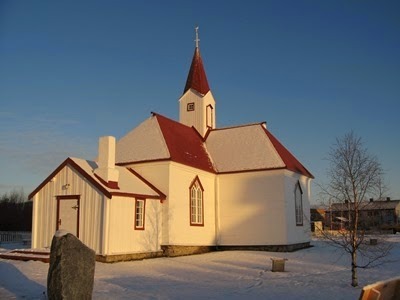 The Old Church in Karasjok, copyright Andrew Eddy, author of Revontuli, 2014
The Old Church in Karasjok, copyright Andrew Eddy, author of Revontuli, 2014
To keep the Red Army from following them into Norway, the Germans decided to adopt a scorched earth policy. The roads behind them were mined. The houses, schools and churches were burned down. Every person in the Finnmark was ordered to choose between mandatory evacuation and summary shooting. Of the population of 100,000 mostly Sami people, about one third chose to resist evacuation, and fled to the woods to avoid being shot. They spent the winter in the woods, waiting for the end of the war. Many died of cold or malnutrition.
For the Sami people, the burning of the Finnmark meant the destruction of their sedentary presence of several hundred years in the Finnmark. Their culture was severely affected, and many of the dispersed Sami did not return after the war.
My novel, Revontuli, is the story of a young Sami woman who falls in love with a German soldier during the war, and must live a difficult separation as the war comes to the Finnmark. The novel provides a very accurate and rare English-language account of this unsung story of World War II, the burning of the Finnmark, and the courage and determination of the people that survived it and rebuilt their towns and villages after the war.
~
 Andrew Eddy conducted extensive research to write Revontuli, including traveling to the Finnmark. He was born in Vancouver, Canada and grew up in Western Quebec and in the Gulf Islands, where he developed an appreciation for nature and became hooked on a rural lifestyle. He has also lived in Paris, Burgundy, Montreal, Knowlton, and Leiden. In 2010 he found a home with his family in Simiane-la-Rotonde, in the hills of Provence, where he farms an ancient grain called einkorn, indulges his passion for history, and prepares his next travels. Andrew is married and has five children. Visit his website at http://andreweddyauthor.com.
Andrew Eddy conducted extensive research to write Revontuli, including traveling to the Finnmark. He was born in Vancouver, Canada and grew up in Western Quebec and in the Gulf Islands, where he developed an appreciation for nature and became hooked on a rural lifestyle. He has also lived in Paris, Burgundy, Montreal, Knowlton, and Leiden. In 2010 he found a home with his family in Simiane-la-Rotonde, in the hills of Provence, where he farms an ancient grain called einkorn, indulges his passion for history, and prepares his next travels. Andrew is married and has five children. Visit his website at http://andreweddyauthor.com.
~
The Burning of the Finnmark, an unsung tale from WWIIAuthor Andrew Eddy shares with readers an introduction to real events that serve as the backdrop to the novel Revontuli.
This year will be the 70th anniversary of the Burning of the Finnmark. If you are like most people outside of Norway, you may not know where the Finnmark is, and may wonder what it offers of interest to a reader. I am myself a passionate reader of WWII historical fiction and non-fiction. I thought I had read stories from almost every theatre of that war, and had heard of the most heart-wrenching tales in sometimes troubling detail.
 For that reason, I was surprised when I stumbled on a real-life love story set to the backdrop of an event that was filled with emotions, trauma and courageous action, and that I had never heard of. It takes place far above the Arctic Circle, in a border region where Norway meets Finland, and its heroes are the Sami, or People of the Reindeer, Western Europe’s last indigenous people. The Sami are traditionally nomadic reindeer herders, living in Norway, Finland, Sweden and the Kola Peninsula in Russia. For several hundred years, Sami settled in the river valleys of the Finnmark and founded villages along old trade routes, mixing with Norwegian populations.
For that reason, I was surprised when I stumbled on a real-life love story set to the backdrop of an event that was filled with emotions, trauma and courageous action, and that I had never heard of. It takes place far above the Arctic Circle, in a border region where Norway meets Finland, and its heroes are the Sami, or People of the Reindeer, Western Europe’s last indigenous people. The Sami are traditionally nomadic reindeer herders, living in Norway, Finland, Sweden and the Kola Peninsula in Russia. For several hundred years, Sami settled in the river valleys of the Finnmark and founded villages along old trade routes, mixing with Norwegian populations. For most of WWII, northern Norway played a discreet role. Its airfields served as rear guard bases for the Eastern Front, and the largest field hospital in history, in Skoganvarre, near Karasjok and Lakselv, received wounded German soldiers from the battles that raged on the road to Moscow and Leningrad. As the war dragged on, German fortunes turned, and the Finnmark would suffer a much harsher fate than occupation by the Germans.
In the fall of 1944, after having fought alongside the Germans for most of the war, Finland signed a separate peace agreement with Russia and agreed as part of that agreement to expulse the German Army from Finland. That expulsion would mean that some 200,000 German soldiers and 60,000 Russian prisoners would walk across the northern part of Finland, into the Norwegian region of the Finnmark, and across this to the sea, at Tromso, where they could be evacuated to Germany. People that watched this evacuation claim that the stream of people walking by lasted for a week. Conditions were hard. It was already fall, and while it was unusually warm, the temperatures were still around freezing in the evening. The troops were ill-equipped and tired. Many died.
 The Old Church in Karasjok, copyright Andrew Eddy, author of Revontuli, 2014
The Old Church in Karasjok, copyright Andrew Eddy, author of Revontuli, 2014To keep the Red Army from following them into Norway, the Germans decided to adopt a scorched earth policy. The roads behind them were mined. The houses, schools and churches were burned down. Every person in the Finnmark was ordered to choose between mandatory evacuation and summary shooting. Of the population of 100,000 mostly Sami people, about one third chose to resist evacuation, and fled to the woods to avoid being shot. They spent the winter in the woods, waiting for the end of the war. Many died of cold or malnutrition.
For the Sami people, the burning of the Finnmark meant the destruction of their sedentary presence of several hundred years in the Finnmark. Their culture was severely affected, and many of the dispersed Sami did not return after the war.
My novel, Revontuli, is the story of a young Sami woman who falls in love with a German soldier during the war, and must live a difficult separation as the war comes to the Finnmark. The novel provides a very accurate and rare English-language account of this unsung story of World War II, the burning of the Finnmark, and the courage and determination of the people that survived it and rebuilt their towns and villages after the war.
~
 Andrew Eddy conducted extensive research to write Revontuli, including traveling to the Finnmark. He was born in Vancouver, Canada and grew up in Western Quebec and in the Gulf Islands, where he developed an appreciation for nature and became hooked on a rural lifestyle. He has also lived in Paris, Burgundy, Montreal, Knowlton, and Leiden. In 2010 he found a home with his family in Simiane-la-Rotonde, in the hills of Provence, where he farms an ancient grain called einkorn, indulges his passion for history, and prepares his next travels. Andrew is married and has five children. Visit his website at http://andreweddyauthor.com.
Andrew Eddy conducted extensive research to write Revontuli, including traveling to the Finnmark. He was born in Vancouver, Canada and grew up in Western Quebec and in the Gulf Islands, where he developed an appreciation for nature and became hooked on a rural lifestyle. He has also lived in Paris, Burgundy, Montreal, Knowlton, and Leiden. In 2010 he found a home with his family in Simiane-la-Rotonde, in the hills of Provence, where he farms an ancient grain called einkorn, indulges his passion for history, and prepares his next travels. Andrew is married and has five children. Visit his website at http://andreweddyauthor.com.
Published on May 26, 2014 06:00
May 21, 2014
Poet's Cottage by Josephine Pennicott, a twisty, long-awaited gothic read
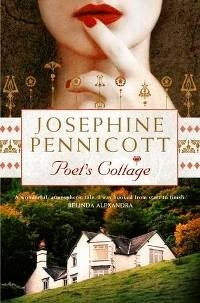 I first came across Josephine Pennicott's Poet's Cottage on Kate Forsyth's blog back in July 2012. A creepy gothic mystery set not in mist-enshrouded England but amid the wild, beautiful landscape of remote Tasmania? It seemed like my type of book.
I first came across Josephine Pennicott's Poet's Cottage on Kate Forsyth's blog back in July 2012. A creepy gothic mystery set not in mist-enshrouded England but amid the wild, beautiful landscape of remote Tasmania? It seemed like my type of book.I added it to my wishlist then but apparently waited too long to buy it since it went out of stock at Fishpond right afterward. For nearly two years, I wasn't able to find it anywhere except in audiobook format. That is, until last month, when Fishpond notified me it was back in stock in paperback. I snagged it right away and set my review books aside temporarily so I could read it as soon as it arrived.
Poet's Cottage shifts easily between timelines set in the 1930s and the present day, but there's nothing nostalgic about the past here. The atmosphere has an edginess that heightens the tension, most of it surrounding the magnetic, abrasive Pearl Tatlow and the violent way she died.
A talented children's author, Pearl comes to live at Poet's Cottage in 1935, when she, her husband, and two daughters move back to Australia from Europe and settle into his hometown, the small fishing village of Pencubitt. Gorgeous and outspoken, she scandalizes everyone with her self-absorbed attitude and bohemian ways, not to mention her reputed affairs and the murder party she hosts.
When she's found stabbed to death in her own cellar, the brash strains of "Ain't Misbehavin'" playing in the background, many people are shocked, but not everyone is terribly surprised or even upset. Pearl is a difficult personality, and probably suffers from what we'd call bipolar disorder today, but she's so compelling that she steals every scene she's in.
Nearly eighty years later, Pearl's adult granddaughter, Sadie, inherits Poet's Cottage and moves there with her teenage daughter Betty after her divorce. Hoping to write a book about Pearl, Sadie makes a new life for herself in this close-knit seaside town, making friends with local women and hearing about her ancestor from two people who knew Pearl well: her friend and early biographer, Birdie Pinkerton, and Pearl's elder daughter, Thomasina, who hated her mother because of her cruelty and abuse.
Pearl's murder was never solved, and Sadie hears talk that her house is supposedly haunted. (Although Poet's Cottage has its own quaint charm, that Sadie and Betty choose to live in a place with such a bloody personal history says much about their strength.) As they learn more about their infamous relative, they find reason to believe that events from the past are reaching out to touch them. What really happened in that grisly cellar? Young Thomasina witnessed the crime, but her account is unreliable. And how much did Birdie know? She did marry Pearl's husband years after the murder, after all...
I found myself wanting more detail on some aspects of the story, such as why Thomasina was treated so poorly by her mother while her sister Marguerite was favored. Also, the reputed health effects of the "Pencubitt air and lifestyle" notwithstanding, the number of extremely spry elderly women from Pearl's time still around in Sadie's era is remarkable.
But these are minor points. Poet's Cottage is a creepy and gripping mystery/family drama with a strong sense of place, and the storyline is even more intricate than what I've described here, but I didn't have trouble following along. If you seek out the novels of Kate Morton, Katherine Webb, and Diane Setterfield, chances are this will be right up your alley, too. Unfortunately it's not available outside Australia, but I got my copy at Fishpond (postage-free) and found the price well worth it.
Poet's Cottage was published by Pan Macmillan Australia in trade paperback in 2012 (371pp, list price A$19.99).
Published on May 21, 2014 17:00
May 19, 2014
Historical Inspiration for The Lost Catacomb, a guest essay by Shifra Hochberg
Shifra Hochberg, a university professor and debut historical novelist, is my guest here today. I was impressed by the extensive on-site research she conducted for her new release, The Lost Catacomb (Enigma Press, March). In the following essay, she intertwines her own background and research journey with information on how she incorporated both of these into her novel. Set in Italy during three vividly described periods – the present day, the 3rd century AD, and WWII – The Lost Catacomb is a thoughtful and erudite yet fast-moving thriller about archaeological and personal discoveries. At its center is Nicola Page, an American art historian with Italian roots who is brought to Rome to examine the provenance of a newly uncovered catacomb; at the same time, she hopes to uncover long-buried secrets about her family. I hope you'll enjoy Shifra's post.
~
Historical Inspiration for The Lost CatacombShifra Hochberg
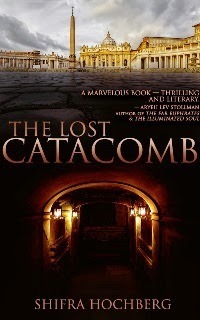 Ever since I can remember, I have been fascinated by Italy—its culture, its rich archaeological heritage, and even its cuisine. And surprisingly, for someone like me who was brought up in an orthodox Jewish home, I have also been fascinated by the Catholic Church—by its power, its wealth, and its prestige. My father was a congregational rabbi in a small Canadian city, and at the time of Vatican II, the revolutionary changes instituted by Pope John XXIII became the subject of Sabbath table talk in our home. Groups of churchgoers suddenly appeared and asked to view our synagogue services in this new atmosphere of ecumenical detente, and my best friend, my Catholic neighbor Janet, no longer had to mention "perfidious Jews" as part of the ritual of mass on Sundays after Vatican II was enacted.
Ever since I can remember, I have been fascinated by Italy—its culture, its rich archaeological heritage, and even its cuisine. And surprisingly, for someone like me who was brought up in an orthodox Jewish home, I have also been fascinated by the Catholic Church—by its power, its wealth, and its prestige. My father was a congregational rabbi in a small Canadian city, and at the time of Vatican II, the revolutionary changes instituted by Pope John XXIII became the subject of Sabbath table talk in our home. Groups of churchgoers suddenly appeared and asked to view our synagogue services in this new atmosphere of ecumenical detente, and my best friend, my Catholic neighbor Janet, no longer had to mention "perfidious Jews" as part of the ritual of mass on Sundays after Vatican II was enacted.
My fascination with Italy and the Vatican, however, explains only one part of the impetus for writing The Lost Catacomb. The other part was inspired by my interest in the Holocaust—with the need to understand how it could have taken place and how differing circumstances in different European countries contributed to such a cataclysmic event. And although I had taken a college course on the history of the Holocaust with Prof. Lucy Davidowicz, author of The War Against the Jews, not much had been written at that point in time on the fate of Italian Jewry.
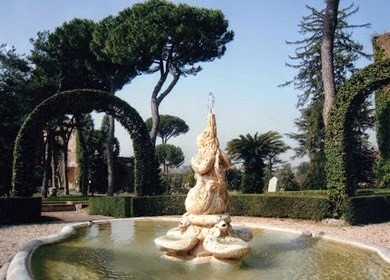 Vatican Gardens
Vatican Gardens
Thus began my research on the history of the Jewish community of Rome, from the days of Julius Caesar through the time of World War II. Over a period of several years I must have read well over a hundred non-fiction books on the history of Italy and the Catholic Church, as well as untold numbers of Vatican and WWII thrillers, not to mention every literary or romance novel about Italy that I could get my hands on.
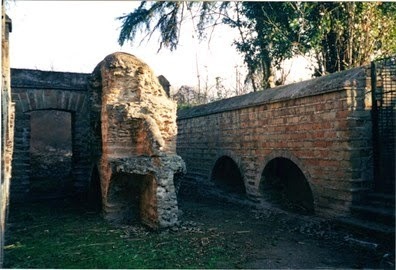 Entrance to the Vigna Randanini catacomb network,
Entrance to the Vigna Randanini catacomb network,
estate of the Marchesa Letitzia del Gallo
I visited Italy over a dozen times, interviewing families of Italian Holocaust survivors, some of whose stories appear in fictionalized form in my novel. I also tried to see every catacomb open to the public in churches and along the Via Appia Antica, including those of San Sebastiano and San Callisto, which figure in my novel; and as the plot line for The Lost Catacomb began to take shape, my husband's Italian colleague, Prof. Bruno Bassan of La Sapienza, arranged for us to visit the catacombs of the Vigna Randanini on the estate of the Marchesa Letitzia del Gallo, which are generally closed to the public.
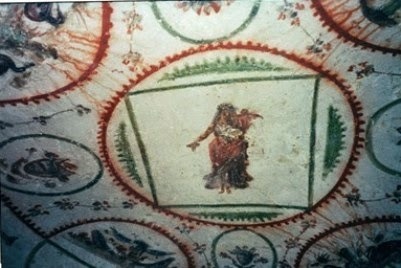 Pagan hypogeum, Vigna Randanini
Pagan hypogeum, Vigna Randanini
These catacombs had begun as pagan burial places and were later extended to include a Jewish underground tomb network. Bruno, my husband and I were accompanied there by a retired archaeologist from the Vatican who had been involved in excavations and restoration work at the Vigna Randanini. Like my protagonists, Nicola and Bruno—who was re-named in memory of our friend, who died of a massive heart attack before my novel was finished—we saw pagan burial chambers, Jewish hypogea and kôchim or layered tombs. All of the details of this catacomb network as presented in The Lost Catacomb are authentic—the gloomy passageways, the dank and chilly air, the marble plaques with their Greek writing, the frescoes and iconography—everything except the titular lost catacomb, which is the product of my imagination.
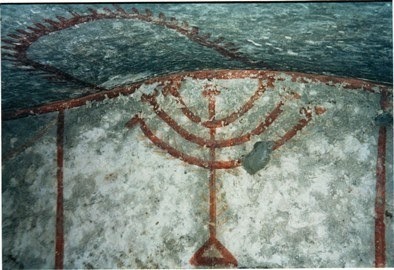 Jewish hypogeum, Menorah detail, Vigna RandaniniApart from several visits to the Vatican Museums and the Vatican gardens, I was also privileged to view a collection of Jewish tomb artifacts that are not open to the general public. This also required special permission and a private Vatican guide. These artifacts included tomb markers from Jewish catacombs which have collapsed over the years and are either no longer safe to visit or have been "lost" to posterity. In fact, they are the only remnants of the once-flourishing synagogai or communities that were scattered around Rome, apart from the Vigna Randanini and the archaeological site of Ostia Antica on the outskirts of Rome, which includes the ancient synagogue where the fictional Mariamne was mater synagogus.
Jewish hypogeum, Menorah detail, Vigna RandaniniApart from several visits to the Vatican Museums and the Vatican gardens, I was also privileged to view a collection of Jewish tomb artifacts that are not open to the general public. This also required special permission and a private Vatican guide. These artifacts included tomb markers from Jewish catacombs which have collapsed over the years and are either no longer safe to visit or have been "lost" to posterity. In fact, they are the only remnants of the once-flourishing synagogai or communities that were scattered around Rome, apart from the Vigna Randanini and the archaeological site of Ostia Antica on the outskirts of Rome, which includes the ancient synagogue where the fictional Mariamne was mater synagogus.
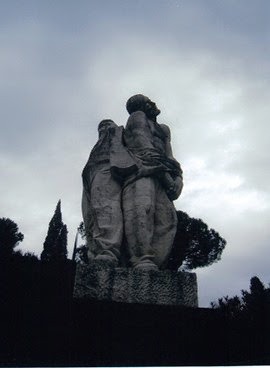 Memorial to victims of the Ardeatine
Memorial to victims of the Ardeatine
Cave massacre, Fosse ArdeatineTo further ensure the authenticity of my setting, I also visited other places that appear in The Lost Catacomb that are not at the top of any must-see list for the average tourist in Rome. These include the Via Rassella, where the Italian Resistenza attacked a group of Nazi soldiers; the Ardeatine caves, where the Nazis executed ten Italians for every German killed in the attack; the Gregorian University, where the fictional Cardinal Rostoni studied; and of course La Sapienza, where the fictional Bruno is a professor in the Archaeology Department.
Other sites include the ghetto and Tempio Maggiore; Santa Maria in Trastevere, where the kindly Father Donato tended his flock of parishioners; Tiberina Island, with the Fatebenefratelli Hospital where both the real and the fictional Bruno's father hid during the war; and even the street where the Villa Wolkonsky—which housed Nazi headquarters in Rome—was located.
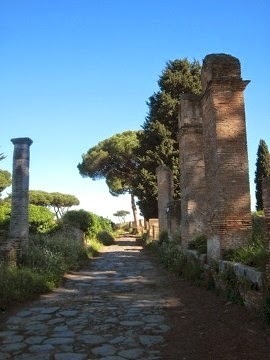 Main artery of the cardo,
Main artery of the cardo,
excavations in Ostia Antica
Having gathered so much material, the challenge then became how to pare it down and make it readable—that is, how to avoid having it sound like a "dryasdust" treatise on history (to quote the famous 19th-century writer, Thomas Carlyle). The narrative needed complexity, but not the kind of complexity that would be dependent on dense historical detail that might bore the average reader. I wanted the end result to be a novel that would reach a wide reading audience—including lovers of historical fiction, those with a specific interest in the Holocaust, and thriller fans who wanted something more than the usual shallow commercial fare.
So I began by making the narrative itself more multi-layered by having Nicola's search for the provenance of the lost catacomb be paralleled by her search for her family roots in Rome. Excavating the past thus became a dual motif. The next logical step was to make Nicola's love story—her relationship with Bruno—be echoed by two other interfaith love stories, that of Mariamne and the lost pope (a figure I based on the tantalizing gap found in the real Liber Pontificalus) and that of Nicola's grandmother Elena and her Jewish boyfriend Niccolò.
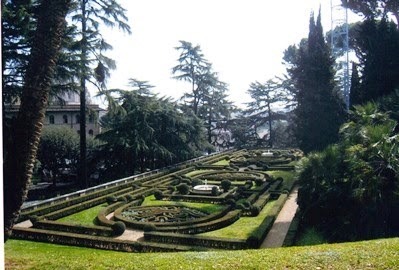 Vatican Gardens, the Pope's personal emblem
Vatican Gardens, the Pope's personal emblem
The motif of loss referred to in the title of the novel also enters the narrative repeatedly, in the form of more than one lost catacomb, a lost pope, lost manuscripts and treasures, lost identity, and lost lovers. And throughout I tried to add a metaphoric backdrop—namely the stars—symbolizing fate and a preordained historical narrative vs. free will or the extent to which man can alter his fate. I also incorporated the myth of Andromeda, which works ironically at times, symbolizing the possibility of rescue—or the failure to be rescued—from the threat of monstrous evil. Yet another layer of complexity was added through the epigraphs that precede each section of the novel and whose function is to elicit a certain element of suspense or expectation, as well as other, more subtle, literary allusions that appear from time to time in the text, including subtexts from Faulkner, Milton, and Shakespeare.
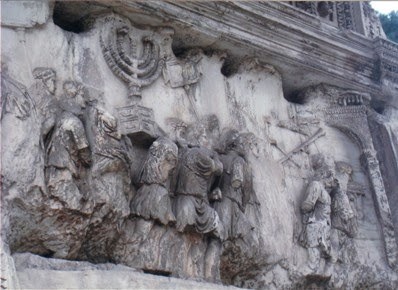 Arch of Titus, relief of Temple treasures being brought to Rome, Foro Romano
Arch of Titus, relief of Temple treasures being brought to Rome, Foro Romano
The photos accompanying this post were taken by me at the Vigna Randanini, the Vatican Gardens, the Foro Romano, the Ardeatine Caves, and Ostia Antica, and I hope that they will help readers further visualize some of the important elements of setting in The Lost Catacomb.
~
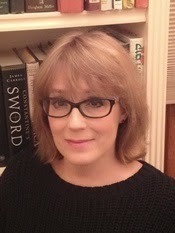 Bio:
Bio:
Shifra Hochberg has a Ph.D. in English literature from New York University and has published over 20 academic essays, mainly in the field of nineteenth-century fiction. Her latest essay, on one of John Donne's poems, is forthcoming in Christianity and Literature. Shifra currently teaches at Ariel University in Israel and is working on a new novel, this time set in France.
Visit her website at www.thelostcatacomb.com.
~
Historical Inspiration for The Lost CatacombShifra Hochberg
 Ever since I can remember, I have been fascinated by Italy—its culture, its rich archaeological heritage, and even its cuisine. And surprisingly, for someone like me who was brought up in an orthodox Jewish home, I have also been fascinated by the Catholic Church—by its power, its wealth, and its prestige. My father was a congregational rabbi in a small Canadian city, and at the time of Vatican II, the revolutionary changes instituted by Pope John XXIII became the subject of Sabbath table talk in our home. Groups of churchgoers suddenly appeared and asked to view our synagogue services in this new atmosphere of ecumenical detente, and my best friend, my Catholic neighbor Janet, no longer had to mention "perfidious Jews" as part of the ritual of mass on Sundays after Vatican II was enacted.
Ever since I can remember, I have been fascinated by Italy—its culture, its rich archaeological heritage, and even its cuisine. And surprisingly, for someone like me who was brought up in an orthodox Jewish home, I have also been fascinated by the Catholic Church—by its power, its wealth, and its prestige. My father was a congregational rabbi in a small Canadian city, and at the time of Vatican II, the revolutionary changes instituted by Pope John XXIII became the subject of Sabbath table talk in our home. Groups of churchgoers suddenly appeared and asked to view our synagogue services in this new atmosphere of ecumenical detente, and my best friend, my Catholic neighbor Janet, no longer had to mention "perfidious Jews" as part of the ritual of mass on Sundays after Vatican II was enacted. My fascination with Italy and the Vatican, however, explains only one part of the impetus for writing The Lost Catacomb. The other part was inspired by my interest in the Holocaust—with the need to understand how it could have taken place and how differing circumstances in different European countries contributed to such a cataclysmic event. And although I had taken a college course on the history of the Holocaust with Prof. Lucy Davidowicz, author of The War Against the Jews, not much had been written at that point in time on the fate of Italian Jewry.
 Vatican Gardens
Vatican GardensThus began my research on the history of the Jewish community of Rome, from the days of Julius Caesar through the time of World War II. Over a period of several years I must have read well over a hundred non-fiction books on the history of Italy and the Catholic Church, as well as untold numbers of Vatican and WWII thrillers, not to mention every literary or romance novel about Italy that I could get my hands on.
 Entrance to the Vigna Randanini catacomb network,
Entrance to the Vigna Randanini catacomb network, estate of the Marchesa Letitzia del Gallo
I visited Italy over a dozen times, interviewing families of Italian Holocaust survivors, some of whose stories appear in fictionalized form in my novel. I also tried to see every catacomb open to the public in churches and along the Via Appia Antica, including those of San Sebastiano and San Callisto, which figure in my novel; and as the plot line for The Lost Catacomb began to take shape, my husband's Italian colleague, Prof. Bruno Bassan of La Sapienza, arranged for us to visit the catacombs of the Vigna Randanini on the estate of the Marchesa Letitzia del Gallo, which are generally closed to the public.
 Pagan hypogeum, Vigna Randanini
Pagan hypogeum, Vigna Randanini These catacombs had begun as pagan burial places and were later extended to include a Jewish underground tomb network. Bruno, my husband and I were accompanied there by a retired archaeologist from the Vatican who had been involved in excavations and restoration work at the Vigna Randanini. Like my protagonists, Nicola and Bruno—who was re-named in memory of our friend, who died of a massive heart attack before my novel was finished—we saw pagan burial chambers, Jewish hypogea and kôchim or layered tombs. All of the details of this catacomb network as presented in The Lost Catacomb are authentic—the gloomy passageways, the dank and chilly air, the marble plaques with their Greek writing, the frescoes and iconography—everything except the titular lost catacomb, which is the product of my imagination.
 Jewish hypogeum, Menorah detail, Vigna RandaniniApart from several visits to the Vatican Museums and the Vatican gardens, I was also privileged to view a collection of Jewish tomb artifacts that are not open to the general public. This also required special permission and a private Vatican guide. These artifacts included tomb markers from Jewish catacombs which have collapsed over the years and are either no longer safe to visit or have been "lost" to posterity. In fact, they are the only remnants of the once-flourishing synagogai or communities that were scattered around Rome, apart from the Vigna Randanini and the archaeological site of Ostia Antica on the outskirts of Rome, which includes the ancient synagogue where the fictional Mariamne was mater synagogus.
Jewish hypogeum, Menorah detail, Vigna RandaniniApart from several visits to the Vatican Museums and the Vatican gardens, I was also privileged to view a collection of Jewish tomb artifacts that are not open to the general public. This also required special permission and a private Vatican guide. These artifacts included tomb markers from Jewish catacombs which have collapsed over the years and are either no longer safe to visit or have been "lost" to posterity. In fact, they are the only remnants of the once-flourishing synagogai or communities that were scattered around Rome, apart from the Vigna Randanini and the archaeological site of Ostia Antica on the outskirts of Rome, which includes the ancient synagogue where the fictional Mariamne was mater synagogus. Memorial to victims of the Ardeatine
Memorial to victims of the Ardeatine Cave massacre, Fosse ArdeatineTo further ensure the authenticity of my setting, I also visited other places that appear in The Lost Catacomb that are not at the top of any must-see list for the average tourist in Rome. These include the Via Rassella, where the Italian Resistenza attacked a group of Nazi soldiers; the Ardeatine caves, where the Nazis executed ten Italians for every German killed in the attack; the Gregorian University, where the fictional Cardinal Rostoni studied; and of course La Sapienza, where the fictional Bruno is a professor in the Archaeology Department.
Other sites include the ghetto and Tempio Maggiore; Santa Maria in Trastevere, where the kindly Father Donato tended his flock of parishioners; Tiberina Island, with the Fatebenefratelli Hospital where both the real and the fictional Bruno's father hid during the war; and even the street where the Villa Wolkonsky—which housed Nazi headquarters in Rome—was located.
 Main artery of the cardo,
Main artery of the cardo, excavations in Ostia Antica
Having gathered so much material, the challenge then became how to pare it down and make it readable—that is, how to avoid having it sound like a "dryasdust" treatise on history (to quote the famous 19th-century writer, Thomas Carlyle). The narrative needed complexity, but not the kind of complexity that would be dependent on dense historical detail that might bore the average reader. I wanted the end result to be a novel that would reach a wide reading audience—including lovers of historical fiction, those with a specific interest in the Holocaust, and thriller fans who wanted something more than the usual shallow commercial fare.
So I began by making the narrative itself more multi-layered by having Nicola's search for the provenance of the lost catacomb be paralleled by her search for her family roots in Rome. Excavating the past thus became a dual motif. The next logical step was to make Nicola's love story—her relationship with Bruno—be echoed by two other interfaith love stories, that of Mariamne and the lost pope (a figure I based on the tantalizing gap found in the real Liber Pontificalus) and that of Nicola's grandmother Elena and her Jewish boyfriend Niccolò.
 Vatican Gardens, the Pope's personal emblem
Vatican Gardens, the Pope's personal emblemThe motif of loss referred to in the title of the novel also enters the narrative repeatedly, in the form of more than one lost catacomb, a lost pope, lost manuscripts and treasures, lost identity, and lost lovers. And throughout I tried to add a metaphoric backdrop—namely the stars—symbolizing fate and a preordained historical narrative vs. free will or the extent to which man can alter his fate. I also incorporated the myth of Andromeda, which works ironically at times, symbolizing the possibility of rescue—or the failure to be rescued—from the threat of monstrous evil. Yet another layer of complexity was added through the epigraphs that precede each section of the novel and whose function is to elicit a certain element of suspense or expectation, as well as other, more subtle, literary allusions that appear from time to time in the text, including subtexts from Faulkner, Milton, and Shakespeare.
 Arch of Titus, relief of Temple treasures being brought to Rome, Foro Romano
Arch of Titus, relief of Temple treasures being brought to Rome, Foro RomanoThe photos accompanying this post were taken by me at the Vigna Randanini, the Vatican Gardens, the Foro Romano, the Ardeatine Caves, and Ostia Antica, and I hope that they will help readers further visualize some of the important elements of setting in The Lost Catacomb.
~
 Bio:
Bio: Shifra Hochberg has a Ph.D. in English literature from New York University and has published over 20 academic essays, mainly in the field of nineteenth-century fiction. Her latest essay, on one of John Donne's poems, is forthcoming in Christianity and Literature. Shifra currently teaches at Ariel University in Israel and is working on a new novel, this time set in France.
Visit her website at www.thelostcatacomb.com.
Published on May 19, 2014 05:00
May 16, 2014
Book review: The Quick, by Lauren Owen
 Owen’s strong debut infuses the classic Victorian-set horror novel with many original, bloody twists. It begins at a decaying Yorkshire mansion, the childhood home of James Norbury and his sister, Charlotte, and later moves over to London. Here James, a new Oxford grad, plans to hone his poetry-writing skills.
Owen’s strong debut infuses the classic Victorian-set horror novel with many original, bloody twists. It begins at a decaying Yorkshire mansion, the childhood home of James Norbury and his sister, Charlotte, and later moves over to London. Here James, a new Oxford grad, plans to hone his poetry-writing skills.Then, suddenly, what seems to be a gothic saga transforms into an intricate, sinister epic involving many unique personalities, immense personal danger, unexpected love, and an unusual pursuit of scientific advancement—all centering on the exclusive Aegolius Club. Revealing any more would be a spoiler.
With her startling plot, Owen proves a master at anticipating readers’ thoughts about future happenings and then crumbling them into dust. Her world building is exceptional, and readers will simultaneously embrace and shrink from the atmosphere’s elegant ghastliness, but the novel’s structure is uneven—it feels overlong in places—and she devotes regrettably little time to her most intriguing characters. It’s an impressive feat, nonetheless, one with the potential to attract a cult (and occult) following this summer.
This review first appeared in Booklist's May 15th issue. The Quick will be published in June by Random House ($27.99, hardcover, 523pp). The hype surrounding this forthcoming novel has been unavoidable, and I don't think it lives up to it, quite, but The Quick does have a lot going for it. If you've read it already, what did you think?
Published on May 16, 2014 12:23
May 14, 2014
My Name Is Resolute, by Nancy E. Turner, an adventurous epic about a courageous woman of early America
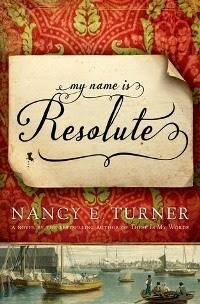 Turner’s engrossing novels always present hardy, intelligent women who endure challenging historical circumstances, and her fifth book is no exception. As Resolute Catherine Eugenia Talbot spins the tale of her long, eventful life, the story zips along merrily while providing superb attention to detail. It is entrenched in its era – the tumultuous decades leading up to the American Revolution – and lets readers experience the ever-changing scenes alongside the heroine: her terrifying time belowdecks on a pirate ship; her degrading years of slavery to a Puritan family; the thoughtful pride she takes in her handicrafts as she secretly works for the patriot cause. And much more.
Turner’s engrossing novels always present hardy, intelligent women who endure challenging historical circumstances, and her fifth book is no exception. As Resolute Catherine Eugenia Talbot spins the tale of her long, eventful life, the story zips along merrily while providing superb attention to detail. It is entrenched in its era – the tumultuous decades leading up to the American Revolution – and lets readers experience the ever-changing scenes alongside the heroine: her terrifying time belowdecks on a pirate ship; her degrading years of slavery to a Puritan family; the thoughtful pride she takes in her handicrafts as she secretly works for the patriot cause. And much more. In 1729, Resolute and her siblings are torn from their British parents’ Jamaican plantation by Saracen pirates. Only ten, she doesn’t see how her older sister, Patience, protects her innocence. Resolute, “Patey,” and their brother, August, are separated and reunite multiple times, their futures determined by their fates on this forced voyage. As a child, she is feisty yet occasionally naïve; as an adult, she is resourceful and devoted to her loved ones.
Resolute’s perspective matures over time, and she learns from both others’ cruelty and kind treatment. Among the best advice comes from a barmy Scottish widow who helps her when she’s left alone in Lexington, Massachusetts: “You must ha’e a boon… a means to go on if all comes to fail. A woman is a fool that lives from penny to farthing and n’er looks to the possibility of loss.” As Resolute settles into her new American identity, she discovers how to ensure her own livelihood – and teaches others the same.
Although fictional, Resolute represents the diverse women whose strength was woven into the fabric of early America. Full of adventure, romance, and unexpected surprises, her account remains captivating throughout its nearly 600 pages. What a fabulous story; what an inspiring life!
My Name Is Resolute was published by Thomas Dunne/St. Martin's Press in February ($27.99 / $31.99 in Canada, hardcover, 593pp). This review as an Editors' Choice title.
Published on May 14, 2014 08:30
May 12, 2014
Iris Anthony's The Miracle Thief, three women's search for salvation in 10th-century France
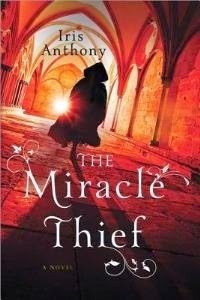 "Freedom! Who are you to speak of freedom? I tell you this: no man on this earth is free. Every peasant bows to his knight, and every knight to his lord, and every lord to his king, and even the king himself bows to God. Who are you to want what none of us ever has one hope of having?"
"Freedom! Who are you to speak of freedom? I tell you this: no man on this earth is free. Every peasant bows to his knight, and every knight to his lord, and every lord to his king, and even the king himself bows to God. Who are you to want what none of us ever has one hope of having?"These forthright words, spoken by a knight in Carolingian-era France (then called West Francia) in the year 911 AD, express a major theme of Iris Anthony's second historical novel. Everyone knows his or her place in this society and has only limited movement within it... and the era's women, whether royalty or peasant, have the most restrictive lives of all.
The Miracle Thief sheds light on women's stories at this dark and distant time through the viewpoints of three protagonists: a nun, a princess, and a pilgrim. Sister Juliana, perhaps the most relatable of the three to modern readers, doesn't believe her faith is strong enough to lead Rochemont Abbey after its previous leader's death. A former royal concubine now in charge of guarding a relic of St. Catherine of Alexandria, she struggles between her vocation and her fond memories of her previous relationship.
Gisele, the illegitimate daughter of King Charles the Simple, may have the harshest fate of the three. Thanks to a truce which her father isn't able to avoid, she's set to be married to Rollo, the pagan chief of the invading Danes. And the plight of Anna may be the most pitiable and desperate. Born with deformities to her hand and body, she can't escape people's belief that she's been cursed by God. When her mother dies, Anna takes to the road from Paris with her meager belongings, alone – something unheard of at this place and time – en route to Rochemont Abbey, high in the mountains of Burgundy, to pray to St. Catherine for a miracle.
This is a novel whose power builds slowly but steadily as the three women's stories draw together and they come to grips with the hands that fate has dealt them. The physical details weren't always vivid enough for me to visualize the locales clearly in my mind, although the setting has a basic medieval feel. A notable exception is Anna's arduous journey on foot – through calm and harsh weather, and with company both congenial and not. These segments also provide darkly humorous insight into the unofficial rules governing pilgrimages.
Anthony delves deeply into the emotional hearts of her characters, showing the small ways in which women could guide their own destinies at a time when society granted them very little. Another strength is her depiction of religion. It doesn't have a preachy feel, but faith in God guides everyone's decisions... well, everyone except the Danes, who live to conquer and pillage, and who will agree (like Rollo) to convert to Christianity if it gains them more power.
In the end, I enjoyed this elegantly written look at an era rarely depicted in fiction. The detailed character notes and author's note at the end add even more meaning to this thoughtful book.
The Miracle Thief was published by Sourcebooks in April ($14.99, pb, 384pp). Thanks to the publisher for granting me access via NetGalley.
Published on May 12, 2014 11:00



